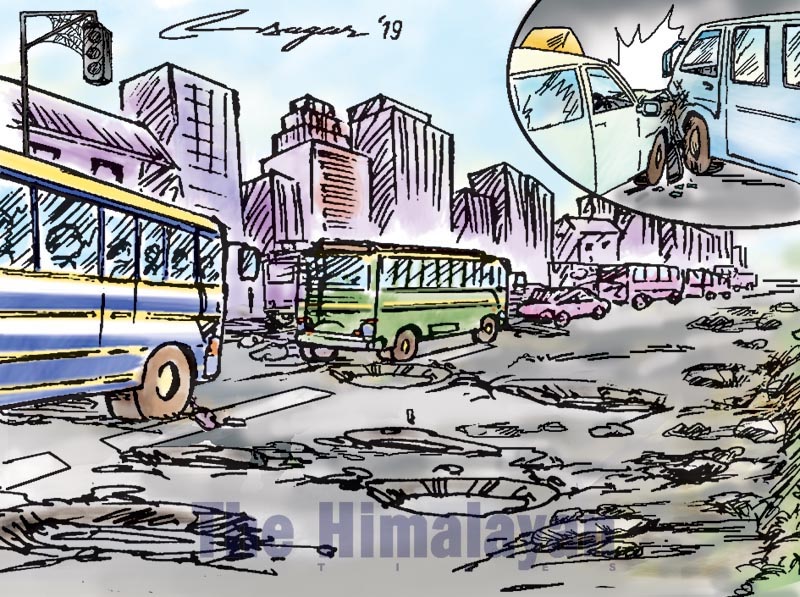Road traffic accidents: An ever-recurring massacre
Safe drivers should be provided suitable incentives. Tax-exemption may be considered for them. Psychological evaluation of drivers should be made mandatory before providing them license
Two media posts were emotionally disturbing for me today. One was on Facebook: A photo of a little baby-girl who missed her parents (rather the whole family) in a terrible bus accident that took place in Sindhupalchowk. The other one was from an online news portal: Deadly statistics regarding recurring road traffic accidents (RTA) in Nepal. For example: 230 people have died due to the RTAs in just 28 days. Just two weeks ago (November 28), a bus accident in Arghakhanchi killed 19 people. Five days later (December 3), 14 died in a Jeep accident in Baglung. During the four-week period, 1,426 people were injured.
In just five months (mid-August to mid-December) this year, there have been 7,505 road accidents, killing 1,030 people, around 100 of them children. If we go through last year’s statistics, on average, seven deaths and 40 injuries are taking place every day due to RTA alone. With the loss of so many productive lives, many more disabilities and massive burden on the dependent family members, I consider these RTAs a form of a recurring massacre.
Recent WHO data (2017) reveal that 3 per cent of all deaths in Nepal are due to RTA. Nepal ranks 79th in the world for RTA-related deaths. Among the SAARC countries, Nepal lies towards the higher side of RTA-related deaths. As per the 2017 data, RTA is the 11th leading cause of death in Nepal, following serious diseases related to the heart and lungs, TB, diarrhea, diabetes, pneumonia and the like. Is this not tragic? In the Kathmandu Valley alone, more than 5,500 RTAs happen every year, with more than 3 per cent leading to deaths.
Why are these tragedies recurring in our country? RTAs are multi-factorial in origin. We can divide the possible causative factors as: a) rider or driver-related; b) vehicle-related; c) environment and road-related; d) other factors like weather and pedestrians. Over-speeding, negligence, lack of rest, lack of proper training, alcohol or drug abuse, disabilities and diseases, lacking education are some of the driver-related issues. Most motorbike accidents in Kathmandu are due to adolescent riders with high thrill-seeking and low harm-avoidance traits. Such personality traits lead to rule avoidance or defiant tendencies. Aggression, hostility, negative attitude towards the government and laws, inappropriate social needs and unhealthy lifestyles may be additional psychosocial factors requiring consideration. These are very important aspects as 70-80 per cent of accidents are said to be associated with human factors, which are usually avoidable.
Mechanical or technical failures or deficiencies, old and poorly-maintained buses and trucks, overloading are some of the vehicle-associated factors. Lack of proper servicing of engines contributes to brake-failure or vehicular collapse. As per 2016 data, 2.5 million vehicles are registered in Nepal and ply on 26,900 km of roads. Half of those vehicles operate in the Kathmandu Valley alone.
Nepali roads are considered to be the most dangerous. Chances of RTAs on these roads are found to be 100 times more than in Japan, and 10 times more than in India. Steep terrain in the hills, snowy mountains and slippery roads after the rains make them accident-prone, particularly in winter and the monsoon. Poor condition of the roads, even in the capital city, with open manholes and rain-damaged structures are an additional nuisance. Lack of traffic lights and poor visibility in the evenings due to absence of street-lights when vehicular speed is uncontrollable make RTAs common during weekends and festival seasons, as reported in a study from western Nepal. Weather conditions are beyond human control. Other factors like unthinking pedestrians and wandering cattle and dogs are also contributory factors to the recurring RTAs.
As the cause is multi-factorial, so is the prevention strategy. There should be a holistic approach. A mass media campaign to change the public attitude on road-safety is necessary. Driving institutes should have an elaborate curriculum regarding traffic rules and road-safety. These institutes should be ranked according to the performance of the drivers trained by them. Safe drivers should be provided suitable incentives. Tax-exemption may be considered for them. Similarly, unsafe/ drunken drivers need proper punishment. Psychological evaluation of drivers (particularly those involved in public transport or night buses) should be made mandatory before providing them the license. Thorough records of their age, marital status and family details should be maintained.
We have examples of the positive effects of the anti-drunk driving rule (so-called mapase) in our country. School curriculum should also incorporate road-safety measures and traffic-injury prevention strategies. Hospitals should enforce trauma-registries. The government should have efficient programmes and sufficient budget not only for developing road networks, but also for road-maintenance, ro-ad-safety and disaster prevention. Unless proper policies are imposed, RTAs will continue to grow and recur, leading to more casualties, loss of life and disabilities among the survivors. Mental health consequences like grief reactions, Post-traumatic Stress Disorder (PTSD), depression, cannot be overlooked in this situation.
Dr Risal is a psychiatrist at Dhulikhel Hospital, KU






